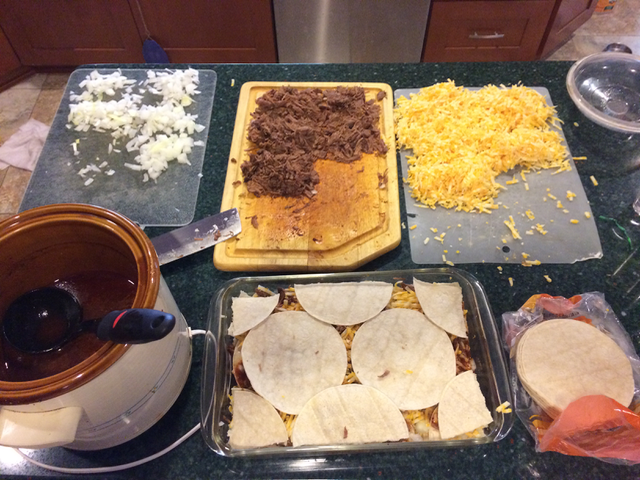So, I like to cook (not bake, but cook). And possibly the first thing I ever really mastered was enchiladas. I’d put a chunk of beef in the crockpot, with a can of enchilada sauce and half-to-most of a beer. (I experimented with making my own sauce for a while, but ultimately the differences weren’t worth it.) After cooking all day, I’d fish the beef out and shred it, grate a bunch of cheese, chop an onion (something my Mom always did), and roll ’em. With some extra across the top.
One of the secrets of my confidence in cooking probably started here. I never had learned that I couldn’t cook, and some early successes kept me going. I’ve subsequently had some fairly big disasters, but I’ve got my repertoire down. And again, while not claiming to be authentic it was considered pretty tasty ;).
 One of the ongoing barriers, however, was the rolling. Really, you want to dip the tortillas in the sauce before you roll them. Diana Kennedy (early source for Comida Mexicana) says you’re supposed to dip them in sauce and then in hot oil, but it’s too messy and even more work. It really slows things down. The question was, is it necessary? Diana Kennedy had also talked about some versions used stacked tortillas, and I finally decided to try it out. I made a batch where I placed the tortillas as a layer, then layered the other ingredients (onions, meat, cheese, and napping with some of the sauce). (Put some sauce in the bottom to keep the tortillas from sticking.) I broke up the tortillas in a way that made it easy to cover. The kids complained about them not being rolled, but I loved how much faster and easier it was. And they tasted just fine. I was sold.
One of the ongoing barriers, however, was the rolling. Really, you want to dip the tortillas in the sauce before you roll them. Diana Kennedy (early source for Comida Mexicana) says you’re supposed to dip them in sauce and then in hot oil, but it’s too messy and even more work. It really slows things down. The question was, is it necessary? Diana Kennedy had also talked about some versions used stacked tortillas, and I finally decided to try it out. I made a batch where I placed the tortillas as a layer, then layered the other ingredients (onions, meat, cheese, and napping with some of the sauce). (Put some sauce in the bottom to keep the tortillas from sticking.) I broke up the tortillas in a way that made it easy to cover. The kids complained about them not being rolled, but I loved how much faster and easier it was. And they tasted just fine. I was sold.
Fast forward a couple more times, and I realized that I had four tortillas per layer (see how they’re broken up to maximize coverage and minimize overlap), and I happened to have 30+ tortillas (fortunately 32+ as it turned out), resulting in eight layers. I also realized that I could mark out how much of the ingredients for each layer (divide in half, and again, and…). (You see in the picture I’ve made 3 layers and have just put down the tortillas for a fourth, which I finished before switching to another pan for the remaining 4 layers.) This was important, because one of the earlier problems was getting the right amount of filling into each roll so as to come out with everything used up at the same time! (You can call it enchilada casserole if you want, but I call it dinner!)
I’ve also adapted it, using pork and green enchilada sauce (you could use chicken too). And for quite a while I’d forgotten the beef and just made cheese enchiladas (then you just warm the sauce in a pan), until I was reminded by a previous happy customer!
And the punchline: meta-learning. Experimentation, observation, reflection, and evaluation. Putting on some music while doing this, and no one else in the kitchen, was what allowed the numerical computation to percolate in the background and sparked the realization. Even in the well-practiced, there’s space for innovation, as long as there remains curiosity, a safe space and willingness to try (and fail), and time to ponder. We can create the environment to do so, and increase the likelihood of continual innovation. And we increasingly need that. So here’s to good eating, and good thinking. Your thoughts?
Love it, Clark.
My first “real” dish was lemon chicken, using a sauce from a jar. Not very gourmet, but like you it gave me the confidence to continue on the path toward mastery.
A part of experimentation, observation, reflection, and evaluation is starting small. It doesn’t have to be the “best”… it just needs to be helpful.
Exactly, Ryan. If you happily ate it, it was a success (it’s a bad cook who doesn’t like their own work ;). And yes, pick a task with your reach but exceeding your grasp. ZoPD and all that!